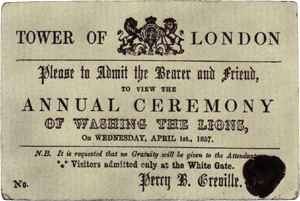Origins.
An 1857 ticket to "Washing the Lions" at the Tower of London in London. No such event ever took place. 
The custom of setting aside a day for the playing of harmless pranks upon one's neighbor is recognized everywhere. Some precursors of April Fools' Day include the Roman festival of Hilaria, the Holi festival of India, and the Medieval Feast of Fools.
In Chaucer's Canterbury Tales (1392), the "Nun's Priest's Tale" is set Syn March bigan thritty dayes and two. Modern scholars believe that there is a copying error in the extant manuscripts and that Chaucer actually wrote, Syn March was gon. Thus the passage originally meant 32 days after March, i.e. 2 May, the anniversary of the engagement of King Richard II of England to Anne of Bohemia, which took place in 1381. Readers apparently misunderstood this line to mean "32 March", i.e. 1 April. In Chaucer's tale, the vain cock Chauntecleer is tricked by a fox.
In 1508, French poet Eloy d'Amerval referred to a poisson d’avril (April fool, literally "April fish"), a possible reference to the holiday. In 1539, Flemish poet Eduard de Dene wrote of a nobleman who sent his servants on foolish errands on 1 April. In 1686, John Aubrey referred to the holiday as "Fooles holy day", the first British reference. On 1 April 1698, several people were tricked into going to the Tower of London to "see the Lions washed". 
In the Middle Ages, New Year's Day was celebrated on 25 March in most European towns. In some areas of France, New Year's was a week-long holiday ending on 1 April. Some writers suggest that April Fools' originated because those who celebrated on 1 January made fun of those who celebrated on other dates. The use of 1 January as New Year's Day was common in France by the mid-16th century, and this date was adopted officially in 1564 by the Edict of Roussillon.
source: Wikipedia
Man Flies By Own Lung Power (April Fool's Day - 1934) Among the papers that printed this photo as an authentic piece of news were the New York Daily News (which, at that time, had the largest circulation in the U.S.), the New York American, the Daily Mirror, and the Chicago Herald & Examiner, See other April Fools Day Hoaxes



No comments:
Post a Comment